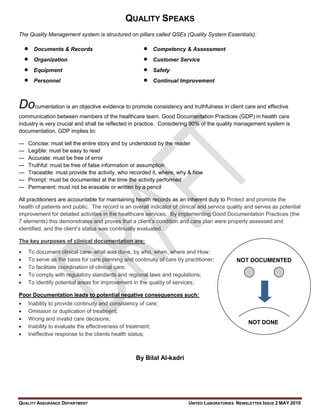
(ULC Newsletter May2010)
- 1. QUALITY SPEAKS The Quality Management system is structured on pillars called QSEs (Quality System Essentials): Documents & Records Competency & Assessment Organization Customer Service Equipment Safety Personnel Continual Improvement Documentation is an objective evidence to promote consistency and truthfulness in client care and effective communication between members of the healthcare team. Good Documentation Practices (GDP) in health care industry is very crucial and shall be reflected in practice. Considering 90% of the quality management system is documentation, GDP implies to: ― Concise: must tell the entire story and by understood by the reader ― Legible: must be easy to read ― Accurate: must be free of error ― Truthful: must be free of false information or assumption ― Traceable: must provide the activity, who recorded it, where, why & how ― Prompt: must be documented at the time the activity performed ― Permanent: must not be erasable or written by a pencil All practitioners are accountable for maintaining health records as an inherent duty to Protect and promote the health of patients and public. The record is an overall indicator of clinical and service quality and serves as potential improvement for detailed activities in the healthcare services. By implementing Good Documentation Practices (the 7 elements) this demonstrates and proves that a client’s condition and care plan were properly assessed and identified, and the client’s status was continually evaluated. The key purposes of clinical documentation are: To document clinical care- what was done, by who, when, where and How; To serve as the basis for care planning and continuity of care by practitioner; NOT DOCUMENTED To facilitate coordination of clinical care; To comply with regulatory standards and regional laws and regulations; To identify potential areas for improvement in the quality of services; Poor Documentation leads to potential negative consequences such: Inability to provide continuity and consistency of care; Omission or duplication of treatment; Wrong and invalid care decisions; NOT DONE Inability to evaluate the effectiveness of treatment; Ineffective response to the clients health status; By Bilal Al-kadri QUALITY ASSURANCE DEPARTMENT UNITED LABORATORIES NEWSLETTER ISSUE 2 MAY 2010